
Tips to help you eat fruits

In general:
- Keep a bowl of whole fruit on the table, counter, or in the refrigerator.
- Refrigerate cut-up fruit to store for later.
- Buy fresh fruits in season when they may be less expensive and at their peak flavor.
- Buy fruits that are dried, frozen, and canned (in water or juice) as well as fresh, so that you always have a supply on hand.
- Consider convenience when shopping. Buy pre-cut packages of fruit (such as melon or pineapple chunks) for a healthy snack in seconds. Choose packaged fruits that do not have added sugars.
For the best nutritional value:
- Make most of your choices whole or cut-up fruit rather than juice, for the benefits dietary fiber provides.
 Select fruits with more potassium often, such as bananas, prunes and prune juice, dried peaches and apricots, cantaloupe, honeydew melon, and orange juice. Select fruits with more potassium often, such as bananas, prunes and prune juice, dried peaches and apricots, cantaloupe, honeydew melon, and orange juice. - When choosing canned fruits, select fruit canned in 100% fruit juice or water rather than syrup.
- Vary your fruit choices. Fruits differ in nutrient content.
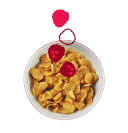 At meals: At meals:
- At breakfast, top your cereal with bananas or peaches; add blueberries to pancakes; drink 100% orange or grapefruit juice. Or, try a fruit mixed with low-fat or fat-free yogurt.
- At lunch, pack a tangerine, banana, or grapes to eat, or choose fruits from a salad bar. Individual containers of fruits like peaches or applesauce are easy and convenient.
- At dinner, add crushed pineapple to coleslaw, or include mandarin oranges or grapes in a tossed salad.
- Make a Waldorf salad, with apples, celery, walnuts, and dressing.
- Try meat dishes that incorporate fruit, such as chicken with apricots or mango chutney.
- Add fruit like pineapple or peaches to kabobs as part of a barbecue meal.
- For dessert, have baked apples, pears, or a fruit salad.
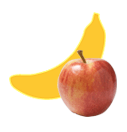 As snacks: As snacks:
- Cut-up fruit makes a great snack. Either cut them yourself, or buy pre-cut packages of fruit pieces like pineapples or melons. Or, try whole fresh berries or grapes.
- Dried fruits also make a great snack. They are easy to carry and store well. Because they are dried, ¼ cup is equivalent to ½ cup of other fruits.
- Keep a package of dried fruit in your desk or bag. Some fruits that are available dried include apricots, apples, pineapple, bananas, cherries, figs, dates, cranberries, blueberries, prunes (dried plums), and raisins (dried grapes).
- As a snack, spread peanut butter on apple slices or top frozen yogurt with berries or slices of kiwi fruit.
- Frozen juice bars (100% juice) make healthy alternatives to high-fat snacks.
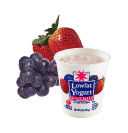 Make fruit more appealing: Make fruit more appealing:
- Many fruits taste great with a dip or dressing. Try low-fat yogurt or pudding as a dip for fruits like strawberries or melons.
- Make a fruit smoothie by blending fat-free or low-fat milk or yogurt with fresh or frozen fruit. Try bananas, peaches, strawberries, or other berries.
- Try applesauce as a fat-free substitute for some of the oil when baking cakes.
- Try different textures of fruits. For example, apples are crunchy, bananas are smooth and creamy, and oranges are juicy.
- For fresh fruit salads, mix apples, bananas, or pears with acidic fruits like oranges, pineapple, or lemon juice to keep them from turning brown.
Fruit tips for children:
- Set a good example for children by eating fruit everyday with meals or as snacks.
- Offer children a choice of fruits for lunch.
- Depending on their age, children can help shop for, clean, peel, or cut up fruits.
- While shopping, allow children to pick out a new fruit to try later at home.
- Decorate plates or serving dishes with fruit slices.
- Top off a bowl of cereal with some berries. Or, make a smiley face with sliced bananas for eyes, raisins for a nose, and an orange slice for a mouth.
- Offer raisins or other dried fruits instead of candy.
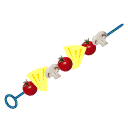 Make fruit kabobs using pineapple chunks, bananas, grapes, and berries. Make fruit kabobs using pineapple chunks, bananas, grapes, and berries.- Pack a juice box (100% juice) in children’s lunches versus soda or other sugar-sweetened beverages.
- Choose fruit options, such as sliced apples, mixed fruit cup, or 100% fruit juice that are available in some fast food restaurants.
- Offer fruit pieces and 100% fruit juice to children. There is often little fruit in “fruit-flavored” beverages or chewy fruit snacks.
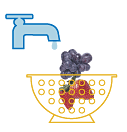 Keep it safe: Keep it safe:
- Wash fruits before preparing or eating them. Under clean, running water, rub fruits briskly with your hands to remove dirt and surface microorganisms. Dry after washing.
- Keep fruits separate from raw meat, poultry and seafood while shopping, preparing, or storing.
This page was last updated on
October 08, 2008 12:49 PM
|

|


|
 |

